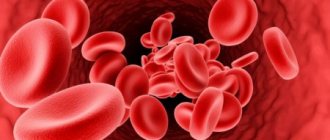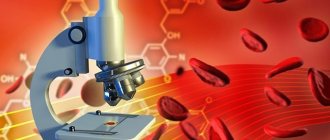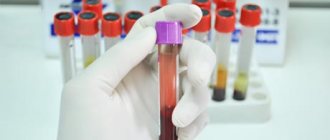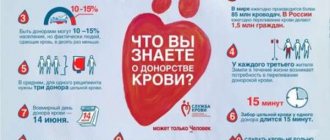One of the key blood test indicators that a doctor evaluates to determine if there are any abnormalities in a patient's health is PCT (the percentage of whole blood volume occupied by platelets). This is a criterion through which it is possible to detect not only current inflammatory processes in the body, but also to examine the general state of the human immune system.
The ability to decipher the results of the analysis, as well as an understanding of what usually causes the actual concentration of platelets in the blood to deviate from the generally accepted norm, will help to identify the onset of the disease and begin its treatment as soon as possible.
Pct - what is it, role and functions in the body
PCT (the abbreviation used to refer to the results of a platelet test) illustrates the status of the portion of the total blood volume that contains platelets. This is an indicator whose level in the analysis is most often determined in an automated way rather than by manual calculation. Its main role is to prevent the progression of dangerous diseases.
The most common among them are:
- thrombosis;
- stroke;
- cerebral hemorrhage;
- causeless internal bleeding.
The criterion under consideration helps to determine:
- How prone a particular person’s body is to bleeding . In cases of obvious predisposition, doctors usually prescribe corrective medications in order to minimize the existing risk.
- The degree or speed of the thrombus formation process . Based on blood clotting, we can predict how likely the patient’s body is to develop a vascular blockage that prevents free blood circulation.
Due to the objective importance of the result obtained, accurate platelet counting, provided by advanced technologies, is more popular than manual counting.
PCT in a blood test is the number of platelets per liter!
If there is insufficient or excessive number of platelets in the body, a person suffers from:
- frequent headaches, migraines;
- changes in skin color of the extremities;
- causeless bleeding (most often from the nose);
- apathy, drowsiness;
- decreased performance;
- severe itching on the fingers or toes;
- pain in the kidneys or liver;
- enlargement of the liver or spleen.
What is thrombocrit (PCT), the norm in a blood test
Thrombocrit is a blood indicator, which in the analysis form is designated as PCT (from the English plateletcrit), measured as a percentage. When the thrombocrit in the PCT blood test is higher than normal, this means that the risk of thrombosis is increased, and this change increases the risk of stroke or heart attack.
A low test result indicates a bleeding disorder, increasing the risk of internal bleeding.
Thrombocrit - what is it?
Thrombocrit is a blood test indicator that indicates what proportion of whole blood consists of platelets. The value of this general analysis parameter is determined only by the hematology analyzer and is calculated using the formula:
platelet count * mean platelet volume (MPV) * 10-4.
The value of the PCT indicator is directly affected by the average platelet volume MPV, as well as factors such as smoking, lack of vitamins B12, B9, B6, and depressive disorders.
Knowledge of the study results allows us to assess the effectiveness of the blood coagulation system. The test indicator reflects the human body’s tendency to bleed or form blood clots.
A thrombocrit test is prescribed as part of a comprehensive examination:
- heart and blood vessels;
- kidney;
- reproductive organs;
- endocrine system;
- respiratory organs;
- immune system.
Based on the test results, the risk of possible complications during organ transplantation is assessed and the course of diseases during treatment with immunosuppressive drugs is predicted.
Knowing the PCT value allows one to assess the risk of thrombosis when prescribing medications that affect the parameters of the coagulation system. Such an assessment is necessary for drawing up a treatment regimen and predicting the outcome of the disease in bedridden patients, with artificial ventilation, and before surgery.
Thrombocrit norm
Normal values for children and adults are the same. The PCT norm in adults and children averages 0.22 – 0.24%.
The normal range is the following values:
- lower limit – 0.11% – 0.15%;
- upper limit of normal – 0.28% – 0.4%.
The permissible limit experiences seasonal as well as daily fluctuations. In spring and at night, thrombocrit is 10% lower. In athletes, regardless of age and gender, the PCT value in the blood can double after physical activity. During menstruation and pregnancy, the test result may decrease by up to 50%.
Signs of deviation from the norm
A characteristic sign of deviation of the test results from the norm is the appearance of bruises on the body in the absence of injuries. Manifestations of the violation also include:
- cyanosis of the skin of the extremities;
- headache;
- decreased vision;
- skin itching;
- the appearance of traces of blood in the patient’s urine and feces.
Reasons for the increase
The PCT thrombocrit indicator in the analysis is increased in thrombocytosis - this condition is characterized by a high platelet count, which is manifested by thickening of the blood, which threatens thrombosis.
A deviation of thrombocrit from the norm is caused by pathologies that are accompanied by increased platelet production.
Thrombocrit levels are higher than normal in diseases:
- bone marrow – chronic leukemia, polycythemia, thrombocytopenic purpura;
- iron deficiency anemia;
- infections – viral, fungal, bacterial;
- diabetes mellitus;
- osteomyelitis;
- atherosclerosis;
- hyperthyroidism;
- ulcerative colitis;
- tissue necrosis.
If thrombocrit values in adults are elevated and their values are more than 0.4%, this indicates the possibility of a heart attack or stroke caused by thrombosis of a blood vessel. The cause of a condition where thrombocrit is elevated may be deep vein thrombosis of the lower extremities, which increases the risk of pulmonary embolism.
A higher than normal thrombocrit in the analysis in women can be caused by contraceptives, and this means that the medication should be discontinued, as changes occur in the blood that increase the risk of thrombosis.
The child's thrombocrit levels are elevated due to iron deficiency anemia, and this indicates that parents need to consult a nutritionist on what to feed the baby correctly for normal growth and development.
Treatment with hormonal drugs and antibiotics can cause an increase in PCT in children. Thrombocrit is increased in a child after an acute respiratory viral infection or influenza; in addition, this sometimes indicates a lack of daily water intake, which affects the condition in children more negatively than in adults.
A decrease in PCT occurs when the production of platelets or platelet precursors, which are megakaryocytes, is blocked. With a decreased PCT, there is a tendency to bleed.
This indicator is reduced during pregnancy. The drop in thrombocrit in women can be 2 times lower than normal, but during pregnancy this reduces the risk of thrombosis, and means that blood circulation and fetal nutrition will not be affected.
PCT decreases in conditions caused by:
- anemia - folate deficiency, aplastic, megaloblastic;
- autoimmune diseases – systemic lupus erythematosus, collagenosis;
- chronic diseases of the liver, kidneys;
- poisoning by poisons, drugs - diuretics, cytostatics, antibiotics, corticosteroids;
- chemotherapy;
- oncological diseases - hemoblastosis, leukemia.
When the thrombocrit is lowered and is less than 0.11%, then in adults this indicates a disorder of hematopoiesis in the bone marrow or an acceleration of the breakdown of platelets in the spleen.
A low PCT thrombocrit in a child’s blood test may be explained by:
- in infants - prematurity, low birth weight, hypoxia;
- in a child of an older age group – parasitic infection.
Norm of thrombocrit in women, men and children
Despite the similarity in the structure of the circulatory system in children, women and men, the generally accepted norm of thrombocrit varies depending on the age and gender of the individual patient.
In a healthy child, the quantitative value of platelets is usually equal to:
| Child's age | PCT reference value |
| From birth to 12 months | 100 – 421*109 cells per liter of blood |
| Over 12 months | 181 – 321*109 cells per liter of blood |
Children often fall, causing them to get cuts, scratches and wounds on their bodies. With a normal thrombocrit, the skin regenerates on its own in the shortest possible time. In addition, platelet cells prevent infection from entering the child’s body through the site of a violation of the integrity of the skin.
For adults, generally accepted reference values are:
| The age of an adult or the characteristics of his condition | Thrombocrit reference values |
| Men from 20 to 75 years old | 0.14 – 0.39% to 1 liter of blood |
| Women from 20 to 75 years old | 0.14 – 0.39% to 1 liter of blood |
| Women during pregnancy or menstruation | 0.07 – 0.21% to 1 liter of blood |
| Elderly people over 75 years old | 0.18 – 0.31% to 1 liter of blood |
When assessing the obtained thrombocrit results, one should take into account not only the patient’s gender and age, but also his lifestyle, as well as factors that have a potential impact on this indicator.
Thrombocrit is higher than normal in a woman
Women are that part of the world's population in which the normal state of platelets is most likely the exception. If women's thrombocrit is higher than normal, this may mean that:
- the lady is extremely susceptible, constantly in a state of stress;
- tries out a new fad diet;
- trying to get rid of edema by reducing fluid intake.
All this is not so serious and can be easily fixed. But there are other reasons that do not depend on the emotional state and desires of the fair half. Especially typical for women is an increase in thrombocrit against the background of gynecological inflammatory diseases. This is a real scourge of our time.
The other half, spending time in queues at the gynecologist's office, are expectant mothers. During pregnancy, the thrombocrit is higher than normal - this means that not one, but two people are in danger. The reason may be:
- severe diarrhea, vomiting (consequences of toxicosis), leading the body to dehydration;
- minimal fluid intake to reduce the urge to urinate;
- indiscriminate consumption of “desired” foods;
- nervous condition.
A critical increase in the number of blood platelets can lead to thrombosis of the vessels that supply the fetus with nutrition and oxygen. The result is termination of pregnancy, miscarriage.
Thrombocrit often increases in women during menopause. This is due to the processes of “restructuring” of the body. In this case, there is an effective remedy that can help not only the suffering woman, but also people who are in dire need of increasing blood platelets.
Thrombocytopheresis is necessary, useful, effective, but very tedious. The essence of the process is:
- in direct drawing of blood from one hand;
- passing it through a special apparatus that “strains” platelets;
- returning the filtered blood to the donor, in the other hand.
Women who decided to undergo this procedure got rid of symptoms associated with elevated platelet levels (dizziness, weakness, numbness of the extremities) and noted a general improvement in their well-being.
It remains to pay a little attention to the representatives of the stronger half of humanity.
Factors influencing the indicator
As with other blood tests, a thrombocrit test may give a distorted result due to the presence of circumstances that influence a temporary change in blood composition.
Among them:
- time of day when biological material is submitted (in the evening, the platelet count may decrease by 5-7% or be at the lower limit of normal);
- seasonal period (in spring and autumn, due to internal physiological changes in the body, the thrombocrit indicator may differ from its normal value);
- menstruation period, during which a woman donates blood (at the beginning of the cycle, the PCT indicator usually decreases significantly by 20 - 40%);
- pregnancy (during gestation, the female body activates all its protective functions, in particular, thins the blood to prevent blood clots);
- excessive physical activity (if biological material is taken after sports, especially cardio exercise, the resulting thrombocrit may be 2 or more times greater than the reference value).
Proper organization of a blood test will allow you to obtain a reliable result, identify abnormalities (if any) and promptly begin treatment of pathological processes that pose a danger to human health.
Thrombocrit is higher or lower than normal: what does it mean?
Thrombocrit is the proportion of whole blood volume that is taken up by platelets (blood platelets).
Thrombocrit in the blood (platelet crit, PCT or pct) is an analogue of hematocrit (HCT), however, if the determination of hematocrit is still to some extent, albeit approximately, possible after spontaneous sedimentation of erythrocytes, then with thrombocrit this is not possible.
Outside the bloodstream, platelets, finding themselves on a foreign surface (for example, in a container intended for blood), receive pseudopodia, significantly increase in size (up to 10 times), then stick together and form aggregates.
This feature of platelets makes their examination problematic, as well as their storage for transfusion (it is necessary to maintain a state of rotation), therefore, in the case of thrombocrit, an automatic analyzer turns out to be indispensable.
Thrombocrit is not widely used.
Why do a thrombocrit test?
Why determine thrombocrit:
- Determining the patient's tendency to increased blood clots or bleeding.
- Thrombocrit can be used to assess the risk of possible complications when choosing preventive treatment.
Any physician should consider the platelet count in the study of his patient's blood clotting.
Typically, platelets are not included in the general indicators, and their analysis is carried out only at the request of doctors. This fact is due to the complexities of thrombocrit analysis technology.
The fact is that platelets have a special property: when moving into a “foreign” space, they grow almost tenfold due to the formation of pseudopodia (false legs). After this, the platelets stick together into aggregates - small particles.
This indicator correlates with the MPV indicator - this is the average volume of measured platelets: the higher the MPV indicator, the higher the thrombocrit (PCT), and accordingly, a decrease has the same effect on both indicators.
What is the normal thrombocrit level?
In a general blood test, thrombocrit characterizes the content of platelet mass in whole blood, informing about an unacceptable increase or decrease in platelets in the patient.
If the thrombocrit is in the range from 0.15 to 0.4, then this means that it is normal (different sources indicate other normal values: 0.11 - 0.28, 0.12 - 0.38, 0.12 -0.36...).
Science does not distinguish between the norm of this indicator in an adult and an infant (that is, if the thrombocrit indicator is elevated in a child, this is not due solely to his age).
The platelet level indicators decrease or increase proportionally in accordance with the age of the patient, so there is no need to look for any differences in children.
Another thing is the physiological fluctuations of platelets:
- Seasonal and daily fluctuations can change the number of platelets by up to 10% (depression in the spring and at night) - the PCT (thrombocrit) indicator may be below normal or at the lower limit of normal.
- Menstruation can reduce PCT in women by 50%; PCT will also be reduced during pregnancy (this phenomenon is associated with the body’s protection from thrombosis).
- Platelets are also affected by physical activity: thrombocrit may increase (the value of the indicator can increase by 2 times).
When does thrombocrit increase?
The reasons for the increase in thrombocrit levels are associated with the reaction to pathology, stimulation of the platelet germ of hematopoiesis.
Most often, PCT values are elevated when:
- Iron deficiency anemia,
- After splenectomy (this is an operation to remove the spleen), an increase in PCT can persist for up to 2 months,
- Blood diseases that are associated with stimulation of the myeloid lineage (essential thrombocythemia, chronic myeloid leukemia, thrombocytopenic purpura, polycythemia),
- Inflammatory diseases of various etiologies (including fungal infections, bacteria),
- Tuberculosis,
- Hyperfunction of the thyroid gland,
- Viral attack (measles, flu, chicken pox in a child),
- Diabetes mellitus
- Laboratory blood tests
- Atherosclerosis of blood vessels,
- Osteomyelitis,
- Ulcerative colitis,
- Rheumatic attack,
- Fractures of tubular bones,
- In smokers - with nicotine intoxication,
- During a large-scale operation,
- Tissue necrosis (acute pancreatitis).
If an increase in this indicator is detected, the patient is at risk of developing:
- Thrombotic stroke (impaired blood supply to the brain).
- Acute thrombosis of coronary vessels with a probability of outcome in myocardial infarction.
The possibility of increased thrombosis should be taken into account when:
- Inpatient treatment,
- Prolonged bed rest,
- Upcoming surgery.
Why does thrombocrit decrease?
If the thrombocrit indicator is low, this indicates:
- Increased destruction
- Inhibition of platelet formation by effects on megakaryoblasts (precursor cells).
Most often, low thrombocrit is due to the following reasons:
- myelodysplastic syndrome,
- Anemia (megaloblastic and aplastic),
- Insufficient nutrition of folic acid, when its content is maintained below the required level for a month or more,
- Allergic diseases,
- Lupus erythematosus, as well as other collagenoses,
- Consequences of a course of chemotherapy,
- Blood tumors (hemoblastosis, leukemia),
- Exposure to toxic substances
- Penetrating radiation
- Negative effects of medications (antibiotics, cytostatics, corticosteroids, diuretics),
- Chronic renal and liver failure,
- Viral infections.
It is found during fetal asphyxia and in low-weight newborns. In older people, a connection between low thrombocrit and exposure to helminthiasis (parasitic infection) has been proven.
A dangerous consequence for the patient’s life can be his tendency to bleed, since any, even minor injuries can cause large blood loss. The most severe manifestation may be hemorrhage in the brain and other organs.
Manifestations of changes in thrombocrit levels
It is mandatory for the attending physician to prescribe a blood test for thrombocrit if there is a suspicion of the above diseases.
You should be aware of symptoms that may be associated with a decrease or increase in platelet count.
The patient has:
- General weakness
- Feeling worse
- Fingers and toes turn blue,
- Headache,
- Bruises form on the body,
- Painful sensations in the fingertips,
- Impaired vision
- Nosebleeds,
- Skin itching
- Blood in stool and urine,
- Women experience heavy periods.
Additional examinations if thrombocrit changes
To diagnose the disease, it is important to determine the cause of changes in thrombocrit levels. And a general blood test may not be sufficient for this.
Checked:
- Blood collection
- Bleeding time
- Clotting factors
- Prothrombin index, fibrinogen,
- Liver tests
- Protein composition,
- blood sugar
- Residual nitrogen, creatinine,
- Iron,
- Analysis of urine,
- If necessary, hormonal composition can be checked.
The doctor prescribes to the patient:
- Hardware studies using radiography and ultrasound.
- To check the patency of blood vessels, Doppler examination is indicated.
- If certain symptoms are detected, magnetic resonance imaging of the brain is prescribed.
- If there is a suspicion of a blood disease, a bone marrow puncture is prescribed.
- The correctness of the hematopoiesis process is checked.
Prevention in case of changes in thrombocrit values
If the thrombocrit is elevated, the doctor prescribes:
- Antiplatelet agents.
- Anticoagulants.
Their intake is necessary to reduce the risk of vascular thrombosis.
The duration of the course and dosage are determined by the attending physician. You cannot increase the dose or stop taking it on your own.
You should consult your doctor about the advisability of taking hormonal birth control and the need for diuretics.
The patient is recommended:
- Stop smoking.
- Avoid alcoholic beverages.
- Drink clean filtered water in an amount of at least two liters/day.
- The daily diet should include:
- Onion,
- Garlic,
- fish,
- Lemons,
- Tomatoes,
- Vegetable linseed oil,
- Fruits and berries,
- Meat,
- Beef
- Buckwheat,
- Liver,
- Dairy products,
- Seafood.
Not recommended:
- Bananas,
- Lentil porridge,
- Walnuts,
- Pomegranates and mangoes,
- Drinks with chokeberry.
If your thrombocrit level decreases, you should include in your diet:
- Vegetables and fruits,
- Be sure to eat fish or meat dishes every day,
- Fresh juices with viburnum, cranberries, sea buckthorn.
It is not recommended to consume products containing acetic acid and preservatives. Homemade preparations are also harmful to the body. You will have to exclude all kinds of allergens (citrus fruits, honey, eggs, chocolate).
To maintain normal thrombocrit, the patient is recommended to:
- Reduce the likelihood of minor injuries.
- Limit physical activity.
- Organize sufficient sleep and rest.
- Refuse vaccinations.
The specific need for a course of treatment when thrombocrit changes is determined by the doctor. If the listed symptoms are detected, you should not self-medicate. Common folk remedies are more likely to harm than help.
Having spent time selecting the “best” treatment method, the patient loses the opportunity to use the minimum doses of necessary drugs, which worsens the prognosis.
Platelets
Loading…
Source: https://KardioBit.ru/krov/o-chem-govorit-otklonenie-ot-normy-pokazatel-trombokrit
When is the test ordered?
A PCT blood test (this is a test that involves counting platelets), usually carried out as prescribed by a physician or hematologist, is considered mandatory for evaluation by a specialist.
According to the recommendations of doctors, it is necessary to take a general blood test for preventive purposes every 5 to 6 months. This will help to adjust its composition in time, without waiting for obvious deviations in health and the development of dangerous diseases.
Therapists usually prescribe this type of study when the patient complains of:
- frequent occurrence of bruises and bruises on the body that are not associated with external influences;
- periodic nosebleeds that cannot be quickly eliminated;
- irregular menstrual cycle (in this case, both the duration of the periods themselves and the number of days included in the menstrual cycle are important);
- excessive bleeding of the gums (if there are abnormalities in the composition of the blood, this occurs every time you brush your teeth, regardless of the type of hardness of the toothbrush used).
If there are no deviations in the result of the thrombocrit test, the therapist refers the patient to a specialist for subsequent identification of disturbances in the functioning of a specific body system (for example, if the gums are bleeding for no reason, the general practitioner will recommend that the person see a dentist).
Preparing for the study
PCT in a blood test (this is the number of platelets that most often occurs per liter of blood) is an indicator that can only be identified if properly prepared for the study.
On the eve of submitting biological material, you should:
- refuse to eat food and liquid (at least 8 hours must pass from the last time food and water entered the body);
- avoid stressful situations and emotional stress;
- minimize physical activity;
- get enough sleep (the optimal length of time for sleep is 8 hours);
- avoid fatty, fried, spicy foods;
- minimize the consumption of flour products and products with a high sugar content;
- make sure there is no elevated body temperature or symptoms of an incipient disease (at least a week should pass from the moment of complete recovery even from a simple ARVI).
If one of the points of the general recommendations is not followed, the resulting thrombocrit indicator will be unreliable, which may subsequently lead to incorrect treatment.
Normal indicators and reasons for the decrease
Throughout a person’s life, the number of platelets in the blood remains unchanged. Concentrations do not differ between men, women and children. The lower limit of the norm is considered to be 0.11%, the upper – 0.4%. A decrease in the indicator can occur at night. There is a dependence of the percentage on the time of year; in spring it is an order of magnitude lower than in other seasons.
Reduced thrombocrit in women during pregnancy and menstruation is explained by the fact that the body seeks to protect itself from blood clots. In people who regularly play sports or their work involves increased physical activity, the thrombocrit is almost doubled.
Low thrombocrit (PCT) is not only an unpleasant, but also a dangerous condition of the body, when the risk of bleeding increases significantly.
When the platelet concentration decreases, the patient may experience the following symptoms:
- General malaise, migraine, blue discoloration of fingers.
- Frequent nosebleeds.
- In women with low thrombocrit, menstruation is accompanied by heavy blood loss.
A reduced concentration of lamellar bodies indicates a disruption in the synthesis or acceleration of platelet breakdown processes.
The main reasons for decreased thrombocrit:
- oncological blood diseases (leukemia);
- poisoning;
- side effects of chemotherapy;
- megaloblastic anemia;
- collagenoses;
- viruses and infections;
- liver and kidney pathologies;
- consequences of taking medications from such pharmacokinetic groups as antibiotics, diuretics, cytostatics;
- folic acid deficiency.
The causes of decreased thrombocrit in children include infection with parasites. Low platelet concentrations are often observed in newborns born before their due date.
What biomaterial is taken for analysis?
To conduct a study on the volume of blood containing platelets, laboratory assistants take blood from a patient's finger.
This method of collecting biological material allows you to obtain the required amount of capillary blood quickly and without additional financial costs for medical equipment (in particular, syringes).
Considering that in some cases the detection of PCT is necessary in small children, a second puncture of the ring finger will allow all the necessary manipulations to be carried out without the need to restrain the resistance of the small patient for a long time.
How is the analysis carried out?
The standard sequence of actions when taking biological material for a general blood test involves the simplest steps.
Among them:
- Clean your hands before taking biological material.
- Make sure that your hands are not cold (the temperature of your fingers should not be lower than 36.6 degrees).
- Disinfect one of the fingers with alcohol or an alcohol-containing product.
- Use a scarifier (a medical instrument that resembles a blade) to make a puncture in the pad of any (usually ring) finger. The depth of the cut should be approximately 2-3 mm.
- Using light pressure on the pad of the selected finger, collect the required amount of blood with a pipette.
- One part of the obtained biological material must be placed in a sterile flask, the other - on laboratory glass.
- Apply an alcohol pad to the cut to stop the bleeding and bandage the finger.
Restoration of the integrity of the skin usually occurs within a few days after taking capillary blood. Sometimes a small hematoma forms at the puncture site, which disappears on its own without the use of medications.
How to normalize thrombocrit
Treatment of low thrombocrit (PCT) consists of identifying and eliminating factors that provoke the deviation:
- The patient is advised to reduce physical activity and avoid damaging the integrity of the skin to prevent bleeding.
- Correcting your diet will be helpful. It is advisable to exclude possible food allergens, give preference to a healthy diet, and be sure to include foods containing large amounts of B vitamins and folic acid in the menu.
- To compensate for the lack of vitamin C, you should take vitamin complexes.
- Until the cause of the disorder is determined, you should refuse vaccination, ensure your body gets adequate sleep and healthy rest, and do not drink alcoholic beverages.
To determine why the thrombocrit has decreased, you will need to conduct a series of instrumental and laboratory studies.
Source: BolezniKrovi.com
Analysis transcript
PCT in a blood test is a number that can be deciphered by assessing the ratio of platelets to the amount of blood being tested. Under normal conditions in an adult, its value should fall within the range from 0.14 to 0.39.
Any deviation from the reference value, subject to compliance with the rules for preparing for the delivery of biological material, as well as conducting the study itself, is considered a sign of the presence of a pathological process in the body. A single discrepancy with the norm is usually confirmed by repeated analysis, but not earlier than a week later.
What is considered normal
A variety of sources indicate different norms for thrombocrit values.
But generally accepted normal values for children and adults are between 0.15% and 0.4%. Due to the fact that the number of platelets for the body is constant at any age, accordingly, its ratio with blood plasma in the analysis will be the same for both children and adults.
Some deviations from the norm are allowed for physiological reasons, which were mentioned above. For example, in a healthy person, during sleep there may be a significant decrease in thrombocrit, which is restored in the morning.
When is additional research needed?
It is advisable to carry out additional examination in the case of the actual platelet concentration, which is significantly higher or lower than the generally accepted norm.
In addition to a repeat general blood test, the patient is recommended to do:
- ultrasound examination of a potentially unhealthy system or organ;
- analysis to determine serum iron levels;
- blood clotting test.
Additional health studies are also needed for people at risk. This is due to the likelihood of transmission of the blood disease at the genetic level.
Low values
An insufficient concentration of platelets per 1 liter of blood negatively affects its clotting. At low thrombocrit values, the risk of causeless bleeding (both external and internal) increases, which will be very difficult to stop.
Depending on the age and gender of the patient, hematologists and therapists differently characterize the identified indicator as low.
According to the standards:
- for women it is less than 0.14%;
- for men - similarly;
- for pregnant women or girls taking a blood test at the beginning of the cycle - below 0.06%;
- for people over 75 years old - less than 0.16%;
- for children aged from birth to 12 months – below 0.1%;
- for children older than one year – less than 0.17%.
The platelet count may decrease due to existing pathological processes or due to previously suffered diseases.
Most often, such changes in the composition of the blood are caused by:
- a tendency to develop anemia (low hemoglobin or “anemia”);
- renal failure;
- liver problems;
- deficiency of vitamins, in particular folic acid;
- infectious or viral disease;
- lupus erythematosus disease;
- existing leukemia or hemoblastosis;
- indiscriminate use of antibacterial and diuretic drugs;
- recently completed chemotherapy;
- intoxication of the body;
- radiation damage;
- underweight;
- the presence of intestinal parasites.
It is possible to normalize thrombocrit levels only with the help of an integrated approach. The patient is usually recommended to review his diet and undergo a course of drug therapy.
In your daily menu you should focus on:
- fruits (bananas, apples, pomegranates, melons);
- vegetables;
- seaweed;
- gluten-free porridges (buckwheat, rice, corn);
- nuts (hazelnuts, walnuts);
- peas;
- beans;
- lean meat (in particular beef);
- fresh herbs;
- green tea
Among the drugs used to increase the level of platelets in the blood, the most effective are:
- "Dicinon" (a drug for the treatment of capillary bleeding);
- "Derinat" (remedy for parasites);
- "Vikasol" (medicine for hemorrhagic disease and hypovitaminosis).
After treatment, it is necessary to take a blood test again to ensure that the thrombocrit level has returned to normal.
Reasons for increased thrombocrit
When stimulating the platelet germ of hematopoiesis, as a rule, the thrombocrit also increases in the vast majority of cases. This is the body’s response to the development of a pathological process.
An indicator above normal is mainly characteristic of patients in the following situations:
- Thrombocytosis.
- Myeloid leukemia, polycythemia vera, primary thrombocythemia, thrombocytopenic purpura, chronic myeloid leukemia.
- Iron-deficiency anemia.
- Splenectomy.
- Infectious diseases of the body of various etiologies.
- Tuberculosis.
- Diabetes mellitus, especially type II.
- Hyperthyroidism.
- Nonspecific ulcerative colitis.
- Atherosclerosis.
- Osteomyelitis.
- Necrosis of tissues of any origin and location.
- Fractures of tubular bones.
- Smoking more than 20 cigarettes per day.
- Rheumatism.
- Extensive surgical interventions.
Despite the variety of reasons, when thrombocrit is elevated, the risk is primarily eliminated:
- Myocardial infarction.
- Acute thrombosis of cerebral vessels.
- Thromboembolism of the pulmonary arteries.
- Thrombosis of the veins of the lower extremities.
No less informative is its reduced levels, which also must be taken into account when diagnosing various diseases.
Increased values
PCT in a blood test is a value that, if exceeded, can cause blockage in the cardiovascular system. In the vast majority of cases, obstructed blood circulation leads to the death of the patient.
Depending on the age of the person, an increased thrombocrit value is:
- for middle-aged men and women – more than 0.39%;
- for people over 75 years old – over 0.31%;
- for children from birth to 12 months – more than 0.41%;
- for children over 1 year old – over 0.31%.
The reasons for the increase in this indicator may be the initial stages of serious diseases in both children and adults.
| Patient's age | Potential body dysfunctions that provoke an increase in platelet levels |
| Children (from birth to 15 years) | Pathological changes in the structure of the bone marrow and disruption of its normal functioning; initial stage of tuberculosis; iron deficiency in the body; blood loss during surgery. |
| Adults (from 16 to 75 years old) | Consequence of removal of one of the organs (usually the spleen); early stage diabetes mellitus; ulcer; gastritis; benign or malignant tumor; purulent-inflammatory processes in the skeletal system; atherosclerosis; consequence of long-term use of steroids. |
To adjust the composition of the blood, doctors recommend that patients eat as much as possible:
- fresh berries (lingonberries, cranberries, blackberries);
- white fish;
- dark chocolate.
If an elevated platelet level persists after adjusting the diet, a therapist or hematologist usually prescribes Angiox to patients. It is used to normalize the functioning of the cardiovascular and circulatory systems. Drugs containing argotroban are considered no less effective in restoring normal AST levels.
Despite the fact that the PCT indicator in the test results may not always reflect a reliable concentration of blood platelets, it is necessary to monitor its level.
This is due to the ability of such a criterion to signal existing pathological processes in the body. By normalizing the thrombocrit indicator in time, a person will be able to avoid not only subsequent drug treatment, but also, in some cases, surgical intervention.
Article design: Mila Friedan
What can affect the diagnostic result?
The result of the analysis may be affected by:
- Seasonal and daily fluctuations (spring, night time, depression) can give an error of 10% upward or downward relative to the norm.
- Menstruation and pregnancy can reduce the rate by 50% - this is the body’s natural defense against thrombosis.
- Physical activity increases thrombocrit levels by 2 times.
An addiction to smoking and eating food immediately before the test can also distort the analysis.
Therefore, for the purity of the analysis, it is necessary to properly prepare for blood sampling:
- You should donate blood only on an empty stomach, and only in the morning. Only drinking clean water is allowed.
- The day before the test, you should avoid salty, spicy and fried foods.
- Avoid alcoholic products.
- Stop taking medications. If they cannot be cancelled, it is necessary to inform the doctor about which medications are being taken.
Blood is drawn from the ring finger or from a vein.
What does it mean: level increased?
The reasons for an increase in thrombocrit above normal in most cases are associated with a disturbance in the process of hematopoiesis, or are a consequence of the body’s reaction to pathological processes occurring in the body and leading to stimulation of platelet production.
A high level of thrombocrit can be observed in the following pathological conditions:
- chronic myeloid leukemia, polycythemia and other myeloproliferative diseases;
- within 2 months after removal of the spleen;
- conditions that are associated with iron deficiency in the body;
- overactive thyroid gland;
- viral and bacterial infections, as well as inflammatory diseases of various etiologies;
- diabetes;
- atherosclerosis;
- smoking.
What does it mean: indicators are down?
Thrombocrit levels below normal are also dangerous. The cause of a decrease in the number of blood platelets, which leads to low thrombocrit values, is most often severe hematological pathology. A decrease in platelet mass in the blood volume may be associated with:
- inhibition of the megakaryocytic germ and a decrease in the synthesis of blood platelets;
- utilization of platelets due to their increased destruction.
This can be observed in various diseases of the circulatory system, as well as in the presence of various chronic processes and under the influence of other factors that negatively affect the functional abilities and number of blood platelets:
- aplastic anemia;
- megaloblastic anemia;
- myelodysplastic syndrome;
- hemoblastoses;
- collagenoses;
- tumors of hematopoietic tissue;
- viral infectious diseases;
- cirrhosis of the liver;
- chronic renal failure;
- intoxication processes;
- exposure to chemicals, including some medications - cytostatics, antibiotics;
- exposure to ionizing radiation.
Of course, not all diseases that can cause an increase or decrease in thrombocrit are listed above, so careful diagnosis and consultation with a doctor is necessary.











